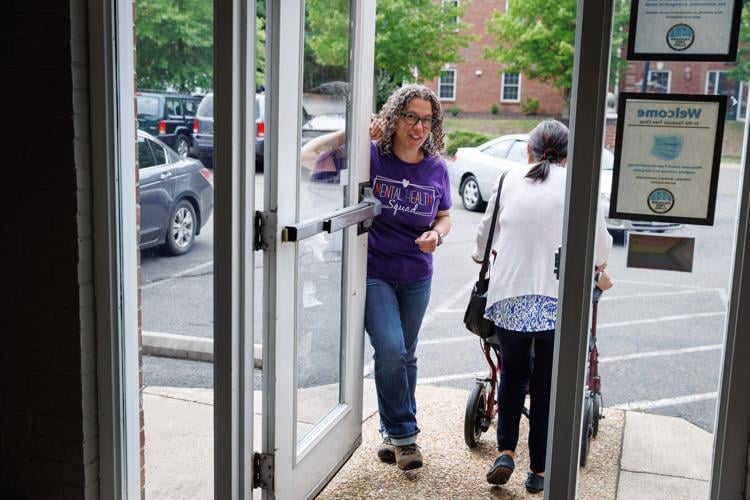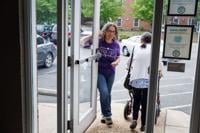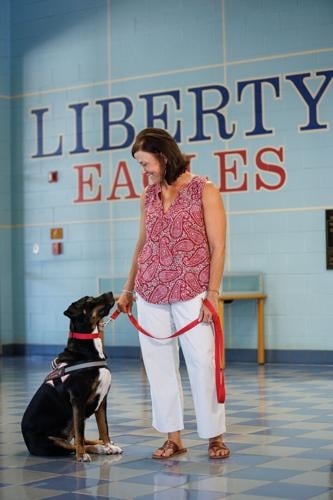This is the second part of a series on the mental health struggles of today’s generation of teenagers, the urgent need for more support in schools and how families can get help. Read Part 1 here.
If there’s any question about how teachers, school administrators and social workers feel about social media, here’s a sampling:
“Social media is the bane of every school administrator’s existence.” – Carol Johnson, assistant superintendent, Rappahannock County Public Schools

Rappahannock County Public Schools Assistant Superintendent Carol Johnson outside her office at RCPS administrative building in Washington, Va.
“If you asked 20 teachers if there should be cellphones in the classroom, 20 teachers would say, ‘No.’” – Tracey Sasso, social worker, Culpeper County Public Schools
“Anyone will tell you that social media wreaks havoc in any school, including elementary schools.” – Deborah Panagos, lead social worker, Fauquier County Public Schools
“Ask any kid and they’re going to say that social media can be stressful, can cause anxiety and can change how they feel about themselves.” – Margaret DiDomenico, assistant head of school, Wakefield Country Day School
When it comes to identifying reasons for the rise in student anxiety, depression and suicide ideation, social media tops most lists. Educators and psychologists point to a cluster of consequences, from adolescents feeling they can’t match the online lives of others, to the ease and unrelenting nature of cyberbullying, to the loss of sleep that comes with late-night scrolling.
In June, no one less than Vivek Murthy, the country’s surgeon general, called on Congress to approve warning labels reminding parents and children that “social media is associated with significant mental health harms for adolescents.” And Jonathan Haidt’s “The Anxious Generation” has been near the top of The New York Times’ nonfiction bestseller list since mid-April. Haidt, a social psychologist, contends that the ubiquity of smartphones and social media has “rewired” children’s brains, leading to the spike in mental health struggles among adolescents and younger kids.

U.S. Surgeon General Vivek Murthy
“Once young people began carrying the entire internet in their pockets, available to them day and night, it altered their daily experiences and developmental pathways across the board,” he wrote. “Friendship, dating, sexuality, exercise, sleep, academics, politics, family dynamics, identity – all were affected.”
But others believe it’s not so simple – that the COVID-19 pandemic, childhood trauma and fewer social connections have also played roles. They see social media as an amplifier of mental health conditions, rather than a direct cause. Last fall, the National Academies of Sciences, Engineering and Medicine released a report that concluded: “Contrary to the current cultural narrative that social media is universally harmful to adolescents, the reality is more complicated.”
A disruptive force
One thing that is clear for those who spend a lot of time with students is that social media has become a chronic, often disruptive force layered over school life.
It can involve insults and name-calling that starts online over the weekend and carries over to the classroom Monday morning. Or it might play out by feeding insecurities when kids are excluded from social loops, making them feel unworthy in a world where popularity and self-worth are defined by “likes.”
On a more basic level, social media has brought a sense of immediacy to young lives, and not in a good way.
“Kids find things out immediately, and for a lot of kids now, it’s very difficult for them to wait and see how something will play out,” said Sasso, the Culpeper social worker. “And if there’s a fight or an argument, people pull out their phones to record it and post on social media instead of stepping in and helping people. Everything is out there now. How can you not have anxiety?”

Culpeper County Public Schools Social Worker Tracey Sasso on her way to the Culpeper Juvenile and Domestic Relations District Court.
Erica Jennejahn, social worker for Rappahannock County Public Schools, agreed that social media can ratchet up conflict, and keep it roiled.
“Situations escalate because kids say things online without knowing why a person may be acting a certain way,” she said. “You can’t imagine how many conversations I have with students where I try to mediate things by getting them to talk to each other face to face.”
Or, as Russell Houck, executive director of student services at Culpeper County Public Schools, put it: “I don’t think kids were so much nicer or empathetic in the past, but today more of the negatives are amplified.”
Cellphones as crutch
School administrators acknowledge that social media is not without benefits. It has, for example, enabled students who struggle with interpersonal communication to connect with similar people. It can reduce the sense of isolation for those who feel they don’t fit in.
It has also become a way for students to become aware of friends who might be considering hurting themselves. “They’ll see something their friend posted on social media,” ejahn said. “More kids are bringing those situations to our attention.”

RCPS Social Worker Erica Jennejahn at the elementary school where she splits her time between the high school.
At the same time, however, social media has widened access to content and information that could be harmful.
“It’s a whole new world out there,” said Shannon Raybuck, mental health care coordinator at the Fauquier Free Clinic. “There are websites that teach you how to have an eating disorder, how to binge and purge and hide it. Or how to engage in self-injurious behavior like cutting and burning.
“If a kid is up at 2 in the morning looking at this, and there’s nobody to turn to at that moment, they’re going to get sucked down that rabbit hole,” she said.
If anything, according to Panagos, the Fauquier County social worker, students seem to be more captive to social media and their smartphones since the pandemic.

Deborah Panagos’ dog Charlotte is in training to be a therapy pet.
“So many kids can’t seem to survive without their phones. It’s become such a crutch for them,” she said. “This is something I feel we’re always addressing. We tell them, ‘You’ve got to be able to function without your phone. When you get a job, you’re not going to be able to check it every five minutes.’”
Public schools in the region have policies restricting cellphone use during the school day, but in July Gov. Glenn Youngkin issued an executive order mandating that all Virginia public schools ensure a “cellphone-free education” by January. The private Wakefield Country Day School already requires cellphones to be kept in students’ lockers while classes are in session.
Pandemic isolation
As children shift more of their focus to digital interactions and virtual relationships, they can become less able to read social cues and pick up on nonverbal communication, Raybuck said. That, she added, can make it harder for them to develop “appropriate peer relationships” or recognize when an adult they’ve met online might be unsafe.

Shannon Raybuck, mental health care coordinator holds the door for a patient at the Fauquier Free Clinic in Warrenton, Va.
The pandemic only seemed to make matters worse, particularly for younger children who, while isolated at home, missed out on learning how to control their impulses and interact with other kids and adults outside their families.
“These are skills they would have picked up naturally through their developmental growth,” said Johnson, the Rappahannock assistant superintendent. “But that’s been delayed, and they’re still learning those things after they get into school. I think that was driving some of the behavior issues we had with younger children.”
Some older children, too, are still showing the effects of being without much structure or face-to-face interactions for such a long time, Panagos said.
“It’s like this weird COVID phenomenon that some kids just can’t get past,” she said. “Maybe we’re starting to come out on the other side, but we still see what it did to kids. It made adjusting back to regular school life very, very difficult for them.”
But Renee Norden, executive director of the Mental Health Association of Fauquier County, believes COVID did have at least one positive effect: The experience made people more open to discussing mental health.
“People who otherwise might not have thought much about mental health saw that loneliness and not being in control has an impact on your mental wellness,” she said. “They understand that now.”
Trauma’s toll
There is also more awareness of the lasting effect of childhood trauma, say therapists and social workers, and for many families, the pandemic, and before that, the opioid epidemic, were times of struggle and crisis.
“Trauma is individual,” said Taisha Chavez, director of children services at the regional agency Encompass Community Supports. “What I find really traumatic might not be so much for you. But when children experience trauma at a very young age, there can be some big challenges later on down the road.”

Community Outreach Specialist Chris Eaglin with Taisha Chavez, director of children services at the regional agency Encompass Community Supports in Culpeper, Va.
For children being raised by grandparents or older relatives, however, those challenges can be misunderstood.
“These older guardians aren’t prepared for the behaviors they’re seeing,” said Amanda Long, director of Culpeper Youth Network, a county agency that works with at-risk youths and their families. “And often they’re not aware of the trauma this child has been through. When the behavior starts to increase, they’re really not sure what to do.”
Not that it’s always easy for kids to talk to their parents. Social workers say students don’t engage in family activities as often these days. And if they have a question, no need to ask mom or dad. They just look it up on their phone.
Part of the problem, said Houck, is that many parents have their own phone obsessions.
“Parents don’t seem to interact with their kids as much,” he said. “They’re not having conversations with them. They’re on social media, too. I’ve been in meetings with parents where everyone was on their phones.”
For Houck, who sees how many children now spend most of their time on their computers or phones, it leads to a sad conclusion:
“We have many kids who are just lonely.”
Students share how social media affects them
An’Aya Payne and Carmen Pond have little doubt about the ripple effects of social media on high school students.

RCHS junior Carmen Pond in her mother Dani's office. Dani Pond is the long-serving director of school counseling.
“A lot of social media can definitely affect how we feel,” said Payne, who’s entering her senior year at Rappahannock County High School. “You know, by comparing ourselves with other people we see online, even with people who may not be real, people who could be photoshopped.”
Pond, who’ll be a junior there this year, agreed. “I definitely think it’s a factor in mental health. People hide behind their screens.They say a lot more mean things than they would say to people’s faces. And I think that gives people low self-esteem, which can be a big factor in causing anxiety.”
Unlike in times past, bullying doesn’t stop at the end of the school day, and nasty comments aren’t heard by only a handful of classmates in the school cafeteria or a locker room. Instead, as school administrators point out, they’re accessible to anyone with a cellphone or laptop, and can live online for a long time.
“I think a lot of people my age don’t understand the concept of consequences online,” said Payne. “I personally have never heard of a case where someone got a consequence for cyber-bullying. It can happen on any platform. In a game. Or a comment.
“I also think that online people get involved in a lot more drama or cancel culture than they would in real life,” she added. “Every social media platform has communities of people who leave comments or posts just to get a negative reaction out of people. It’s rage bait.”
Pond believes the addictive quality of social media can exacerbate mental health issues. “Some people have an addiction to social media whether they want to admit it or not,” she said. “I have a friend who suffers from anxiety, and I really think that one reason is that she’s always on her phone, I just think it’s a big factor.”
It’s no secret that the business model of most social media platforms is to keep users engaged–and exposed to advertising–for as long as possible by constantly feeding them content tied to their personal interests and viewing habits.
“That can cause a lot of addiction,” said Payne.
“The convenience of having a form of short-form entertainment, like TikTok or Reels, in the palm of your hand makes it easier for you to get sucked in online,” said Pond. “Social media makes the videos short enough to entertain you for hours, and the videos are programmed just for you. Getting offline and off the app is hard once you log on.
“Posting online can be addictive as well,” she added. “The high of getting likes from your post and the chance that you might go viral is exhilarating. It is addictive to share what you’re doing with the world because it makes you feel important.”
Sign up for Rapp News Daily, a free newsletter delivered to your email inbox every morning.
While both Payne and Pond acknowledge that social media can provide comfort and connections for teenagers who otherwise feel isolated or mocked, they think it also takes a toll on the social skills of many others.
“We’re so used to being able to talk to people online, and it’s so much easier than actually socializing, that we don’t give ourselves the time to go hang out with people,” said Payne.
“Sometimes for the people who struggle the most, the only people they feel they have are their friends,” she added. “Not their parents, not their teachers, just their friends.
“I think having a group of friends, an unbreakable one, that’s one of the best things you could have.”
— Randy Rieland
What parents can do
A year before U.S. Surgeon General Vivek Murthy called for placing warning labels on social media websites, he was already recommending that parents set limits on their children’s phone use.
He pointed out research showing that as many as 95% of children between ages 13 to 17 say they use a social media platform, and more than a third say they use social media “almost constantly.”
According to a 2023 Gallup Survey, teenagers in the United States spend an average of almost five hours every day on social media platforms. Girls average an hour a day more than boys.
Also, a 2022 study published in the journal Nature concluded that there are two age periods when social media is more likely to have a negative impact on an adolescent’s well-being – at the start of puberty and then around age 19.
As Murthy pointed out, the onus for protecting children from the dark side of social media still falls largely on parents.
So what can they do?
Here are suggestions from the Amn Psychological Association:
• Developing brains may be particularly vulnerable to social media elements, such as “Like” buttons and features that encourage excessive scrolling. Set limits on how much time kids spend on their phones, and create screen-free times and places. Also, prohibit screen time that prevents a child from getting eight hours of sleep.
• Make a point of talking to your teens about how they use social media, and how it can lead to bullying. Spend time explaining how social media platforms work so they feel safe telling you about their experiences.
• Teach them to silence phones during time spent with others, and to learn to pause before sending messages. Also, that they shouldn't use phones while driving.
• Emphasize that if they receive an inappropriate photo, they should delete it, block the sender and notify an adult.
• Set limits for your own social media use. Avoid using it during meals and family activities, and take social media breaks as a family.
• Keep an eye out for signs that social media is interfering with your child’s daily routines, and prevents them from spending time with friends or engaging in physical activity. If that’s the case, set new limits and consider taking them to see a therapist.
— Randy Rieland
Resources for parental control
As they’ve come under increasing fire for the harmful aspects of social media, tech companies have made more protective tools available to parents and caregivers.
These parental controls allow them to monitor and filter what children can see online, and to set limits on screen time and app purchases.
Here’s where to find more information on supervision tools for popular devices and websites:
• Apple iPhones and iPads: Under the settings app, Screen Time enables parents to manage content, apps and settings on a child’s device.
• Android devices: TheGoogle Family Link app, installed from Google Play, allows parents to limit screen time and manage a child’s online activities.
• Meta: The Family Center is where parents can supervise Instagram and Facebook accounts and get advice from experts.
• TikTok: The Family Pairing feature enables a parent or guardian to link to a teen’s account and set controls.
• YouTube: Supervised accounts include a content setting that limits the videos and music children under 13 can play.
• Snapchat: This app also has a Family Center with tools and resources for parents or guardians.
Another resource for developing a digital management strategy is the Family Online Safety Institute website.
— Randy Rieland

Foothills Forum is an independent, community-supported nonprofit tackling the need for in-depth research and reporting on Rappahannock County issues.
The group has an agreement with Rappahannock Media, owner of the Rappahannock News, to present this series and other award-winning reporting projects. More at foothillsforum.org.



















(0) comments
Welcome to the discussion.
Log In
Keep it Clean. Please avoid obscene, vulgar, lewd, racist or sexually-oriented language.
PLEASE TURN OFF YOUR CAPS LOCK.
Don't Threaten. Threats of harming another person will not be tolerated.
Be Truthful. Don't knowingly lie about anyone or anything.
Be Nice. No racism, sexism or any sort of -ism that is degrading to another person.
Be Proactive. Use the 'Report' link on each comment to let us know of abusive posts.
Share with Us. We'd love to hear eyewitness accounts, the history behind an article.